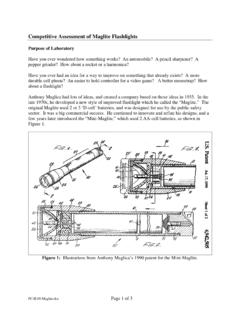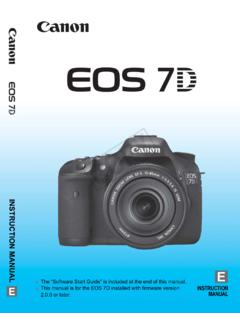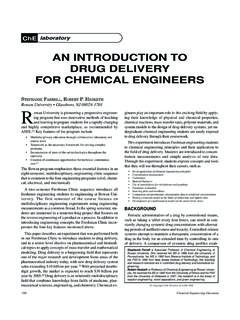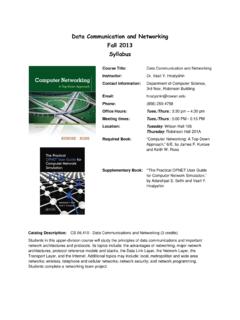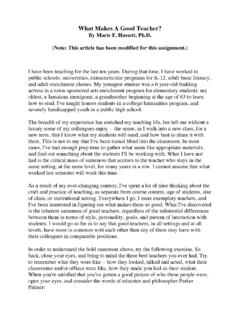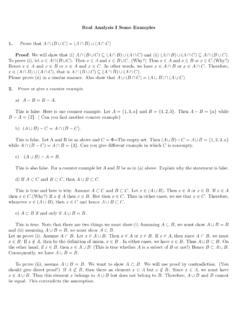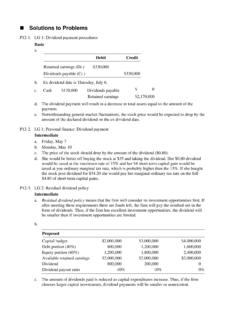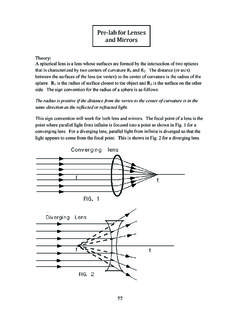Transcription of Optics: Lenses and Mirrors - Rowan University
1 1 Optics: Lenses and Mirrors (7/16/15) (completion time: approx. 2 h) Introduction Mirrors reflect light while Lenses transmit light. Both can form images, however. In this lab you will study spherical Lenses and Mirrors . A spherical surface is simply some portion of the surface of a sphere. It is characterized by its radius of curvature, R. Equipment optics bench light source metal screen & 5 x7 card 1 concave lens (f = -150mm) 2 convex Lenses (f = 100 & 200mm) spherical and cylindrical Mirrors pencil & eraser dim lamp rulers grid paper lamp for instructor Recommended Demo: Mirrors : Plane, Concave and Convex Theory A spherical mirror is a section of a sphere.
2 If the shiny side is inside the sphere it is a concave surface (Figure 1). If the mirror is on the outside surface then it is convex. As with all Mirrors , light reflecting from the surface obeys the law of reflection: The reflection angle is equal to the incident angle. The normal to a spherical surface passes through its center of curvature along a radius. From this it can be shown that rays parallel to the optic axis of a concave spherical mirror will all be reflected toward the focal point (converging). Rays reflected from a convex spherical mirror will diverge away from a focal point behind the surface.
3 (See Figure 2) The focal length (distance to focal point) of a spherical mirror is given by: 12fR or, fR 2. Lenses form images by refracting light. A spherical lens can be made of any transparent material with a curved surface and an index of refraction that differs from the medium it s in. For a lens (in air) with index of refraction n, and spherical surface(s) of radii R1 and R2, the focal length is given by 111112fnRR Center of curvature R Focal point Optic Axis f Figure 1: A concave spherical mirror. Object Image Object focal point Virtual Image Figure 2: Concave converging mirror (top) and convex diverging mirror (bottom).
4 Lenses and Mirrors 2 For a spherical lens, parallel light incoming to a lens with convex surfaces will converge on its focal point, while parallel light incident on a concave lens will diverge away from its focal point (Figure 3). The image location for either Mirrors or Lenses can be found by a ray diagram. A ray diagram is constructed using the following rules for a converging (or diverging) lens: Parallel incoming rays will be refracted towards (convex lens) or away from (concave lens) the focal point. Incoming rays from or towards the focal point will be refracted so they are parallel. A ray through the center of a lens is unchanged.
5 These rays are shown respectively in Figure 3. A real image is formed if the rays from the object all intersect at a point. If they diverge when exiting the lens, a virtual image is found by tracing them back behind the lens. Similar rules apply to Mirrors as shown in Figure 2. The magnification of an image is the ratio of image height (h ) to object height (h). Drawing similar triangles shows that this is equal to the ratio of image distance, i, to object distance, p. The relationship between image distance, object distance and focal length is given by: 111pif . The magnification is given by: mhhip '.
6 A negative magnification indicates an inverted image. Object distances are positive when on the incoming side of the lens (or mirror). Image distances are positive on the opposite side. Focal lengths are positive for converging Lenses and negative for diverging Lenses . Figure 3: Converging (left) and diverging (right) Lenses Lenses and Mirrors 3 Procedure Part A: Spherical Mirrors . a) Finding the focal length and radius. Light from an object located very far away is nearly parallel. This can be used to find the focus of a concave spherical mirror. If it is light outside, take a mirror and a white card to the window.
7 Raise or lower the shade and blinds to just a few inches above the sill and turn off the light to darken the room. Hold the white card against the wall just below the window sill and adjust the position of the mirror until the image of a distant object ( a building or a tree) is focused on it. If the sun is in your image it might be so bright that it is difficult to see other objects, so concentrate on focusing the image of the sun. (If it is dark outside, use a point-like light source, such as an incandescent light bulb, far from the mirror and focus the light to as small a point as possible on the card). Measure the distance from the mirror to the card (with a helping hand if needed).
8 Record your data and calculations beginning on page 5. Have a second person repeat the measurement and compare. Average the results. Calculate the radius of curvature of the mirror using your average. Does your answer seem reasonable? Draw a ray diagram for the mirror showing the light coming in parallel and converging on the focus. b) Images in spherical and cylindrical Mirrors . Hold one hand up next to your face. Hold the spherical mirror so that this hand is farther than the focus. Tilt the mirror until you see your hand. Describe what you see. Is the image upright or inverted? Smaller or larger? Make a ray diagram for a spherical converging mirror and an object farther than the focus.
9 Explain whether or not your diagram agrees with your observations. Repeat these two steps using the convex side of the mirror as a diverging mirror. (You can look directly at your face instead of your hand now). Look at your facial images in concave and convex cylindrical Mirrors . What do you see? How do they compare to those in the corresponding spherical Mirrors ? How do they compare to your image in an ordinary, flat mirror? Explain why the images in the cylindrical Mirrors look the way they do. Part B: Spherical Lenses Here you will set up the Lenses on an optical bench and find the images of the illuminated source. First try to use a screen to find the image.
10 If you cannot do this it may be a virtual image. In this case you can look through the lens to see the image but cannot actually measure the image distance. In each case you should record the relative size and orientation of the image. a) Convex (Converging) Lenses Measure image distances and observe the size and orientation of the image for the following cases using a +200 mm focal length lens: object ( Pasco light source) distance = 30cm, 45cm, 60cm & 75cm. For the 30 cm and 60 cm object distances, draw ray diagrams (use ). Label everything in your diagrams to explain what it is. The diagrams should be to scale and drawn accurately with a ruler.
